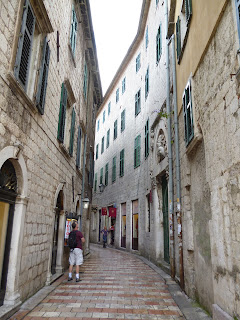 We took a second road trip. This time south from Dubrovnik to the country of Montenegro.
We took a second road trip. This time south from Dubrovnik to the country of Montenegro. 
When it was part of Yugoslavia, it was mostly deemed a urban workers country, but if you go past the fairly dreary towns, you reach a stunning countryside that looks somewhat like Germany or Switzerland.
Beautiful mountains reach down to the water, and small villages cling to the shores at their base.
 It had rained heavily the night before, so rivers flowing into the inland seas were bountiful.
It had rained heavily the night before, so rivers flowing into the inland seas were bountiful.One river emerges out of an underground tunnel in the side of the mountain, flows under the highway bridge and then flows into the ocean. Strange to see such a fast flowing river just coming out of the side of the hill

Here in this mix of fresh and salt water, Oyster farms are in abundance. Though not a huge fan of oysters, the large number of farms made me want to try some.

It was morning, so after a couple hours of driving to get here, we stopped for a cup of "local" coffee, which is essentially Turkish Coffee. It was very strong and very good. Again, you just didn't want to drink it all the way down to the last bit, or you would be in for a gritty surprise.
Our ultimate destination was the city of Kotor. It is one of the best preserved Medieval Walled Cities on the Adriatic Sea.
It has been a major port city, but Montenegro has been in decline since its secession from Yugoslavia in the 1980's.
The entrance dates back to the 14th and 15th century, but was updated under Tito to have his slogan, which in English is translated as "What is yours, we'll leave alone, but we will fight to keep what is ours."
Just inside the gates is a cool old clock tower.
And a small pyramid, which is where people who had been bad would have been tied up to to be punished.
Like many medieval cities, Kotor is a maze of winding alleys.
The main site in Kotor are the walls that stretch up into the hillsides behind the Cathedral of Saint Tryphon a la the Great Wall of China.
We had lunch in the square in front of the church at a quiet pizzaria, and besides the great pizza and
and some great Montenegrin wine, I had the view of the church and hillside above. Amazing.

After lunch I went inside the church. It is an amazing blend of gothic and moorish architectural styles, and you can easily see the mixing of Western and Eastern aesthetics.
Upstairs you can see the remains of Saint Tryphon, the protector of Kotor, whose bones are encased inside a silver casket and head inside a gold chalice. Strange, but true.
I also poked my head inside a Serbian Orthodox church, which also felt very moorish, blending Eastern and Western design elements.
Kotor is a wonderfully picturesque town, and around every corner I found interesting things of which I wanted to take pictures. Even the mundane things seemed exotic and foreign in a city with this much past.
It is clear that buildings have come and gone, and been evolved into new structures.
For the drive back to Dubrovnik, we elected to take the ferry back across the inland sea and avoid driving all the way back around it. This saved us some time, and was a fun way to get back as well.
Unfortunately, Tony got a little seasick. . .
We made it back to Dubrovnik in time to watch the sun set over the Adriatic one last time.
That evening, we had a wonderful steak and terrific bottle of Dingac wine to soften the blow that our wonderful Adriatic vacation was coming to an end.
From our seat in the plane, we got one last aerial view of Dubrovnik with its orange terracotta roofs and its wall.
I'll be remembering this trip for a long time. And perhaps someday, I'll get the opportunity to return.
























No comments:
Post a Comment